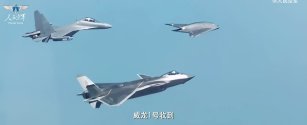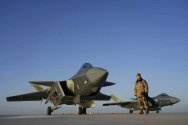You are using an out of date browser. It may not display this or other websites correctly.
You should upgrade or use an alternative browser.
You should upgrade or use an alternative browser.
J-20 5th Gen Fighter Thread VIII
- Thread starter Blitzo
- Start date
The video indicated that it was actually the J-20 (and a single-seater, non-A/S variant at that!) which was collaborating with the GJ-11.
Ground/AEW&C Controller:
J-20 Pilot:
View attachment 164360
To add - I suppose this should serve as a tacit nod (if not confirmation) that single-seater 5th-gen fighters (i.e. J-20/A and J-35), let alone single-seater 6th-gen manned warplanes (i.e J-XDS) in the PLAAF (and the PLAN as well) are capable of conducting MUMT with UCAVs (including ULWAs and UADFs) as well, and that MUMT capability is not limited to twin-seater 5th-gens (i.e. J-20S) and 6th-gens (i.e. J-36).
This is indeed a monumental development milestone to behold.
plawolf
Lieutenant General
is this the first video we've seen of it controlling a CCA?
I would say it’s more commanding than controlling. One of the main reason GJ11/21 took so long was because of the complex flight control requirements. I understand that to not just be the aerodynamics of flight itself, but also needing to add sufficient automation as to minimise external command inputs such that a single seat manned combat aircraft can effectively utilise them in complex combat situations without compromising its own combat effectiveness. In that context, there is a quantum leap between controlling and commanding.
The J-20 has the stripes associated with airframes that participated in the parade, so am I right in assuming that it's from the 2nd Air Brigade?The video indicated that it was actually the J-20 (and a single-seater, non-A/S variant at that!) which was collaborating with the GJ-11.
Ground/AEW&C Controller:
J-20 Pilot:
View attachment 164360
My gut feeling is that they did this shoot during the timeframe when all the jets were at the same base for the parade's rehearsals, but gut feelings aren't to be trusted lol
lcloo
Major
The actual convesation between flight control and the J20 pilot-
Flight Control: 威龙一号,玄龙08已达6号阵位。Weilon 1 (J20 call sign), xuanlon 08 (GJ11/21 call sign) has reached position #6.
J20 pilot : 威龙一号收到。已和玄龙协同。Weilon 1 roger, have "in coordination; cooperate with; work in coordination with" xuanlon.
协同 in dictionary is "in coordination; cooperate with; work in coordination with".
协同(拼音:xié tóng),汉语词汇,指不同个体通过相互配合共同完成目标的行为能力,其核心内涵为系统内元素通过协调合作形成整体功能增强的效应.
Flight Control: 威龙一号,玄龙08已达6号阵位。Weilon 1 (J20 call sign), xuanlon 08 (GJ11/21 call sign) has reached position #6.
J20 pilot : 威龙一号收到。已和玄龙协同。Weilon 1 roger, have "in coordination; cooperate with; work in coordination with" xuanlon.
协同 in dictionary is "in coordination; cooperate with; work in coordination with".
协同(拼音:xié tóng),汉语词汇,指不同个体通过相互配合共同完成目标的行为能力,其核心内涵为系统内元素通过协调合作形成整体功能增强的效应.
The video indicated that it was actually the J-20 (and a single-seater, non-A/S variant at that!) which was collaborating with the GJ-11.
Ground/AEW&C Controller:
J-20 Pilot:
View attachment 164360
Collaboration does not necessarily mean direct control. Either way controlling a drone/CCA is not pilot directly flying them like an RC plane. It is more like RTS where you give it a task and watch it perform. But doing so still requires screen time so having someone other than the pilot handling it is optimal.
Collaboration does not necessarily mean direct control. Either way controlling a drone/CCA is not pilot directly flying them like an RC plane. It is more like RTS where you give it a task and watch it perform. But doing so still requires screen time so having someone other than the pilot handling it is optimal.
I want to address that bolded part again, because what you are talking about is entirely dependent on the task you are giving to the drone and the extent of automation that your collaborating manned aircraft has in context of other tasks.
If your drone is simply being told to fly in formation alongside a manned aircraft as a reference, or doing a preset patrol over a designated target area, etc, then that is something easier to automate than having a drone actively search among a variety of ground based targets to identify a specific vehicle type or building to strike.
The sophistication of the task in turn relates to what the onboard command capability your collaborating manned aircraft has -- which is dependent on crew size yes, but it also depends on the automation it has, the more of the aforementioned task it can do (whether it's simple or complex). And naturally if your manned aircraft itself has to focus on a complex tactical situation itself, then that will reduce the net capability to effectively command the drone, in relation to the sophistication, and automation.
A simple expression of it might be:
Drone command capability for a given task ∝ (Automation x Crew Size x Drone Task Simplicity)/(Manned aircraft task complexity)
In this case, given they're doing a simple formation flight (aka high Drone Task Simplicity), and considering the Automation capability of a J-20 likely is not inferior to a J-16D, and given the J-20 itself is just flying in a formation (aka relatively low Manned aircraft task complexity), then it should be very plausible for a single seat J-20 to command this drone for this specific task, even though it is "only" one single crew member versus two in the J-16D.
Putting it another way, I wouldn't be surprised if a single-seat vanilla J-20 can probably command many more drones for this specific task (flying in formation) than just a single GJ-11... therefore we should stop thinking about things like "drone command" as being something that is relegated to twin seat aircraft.
If one held all else equal (Automation, Drone Task Simplicity, Manned aircraft task complexity), then yes the Crew Size would positively correlate with "Drone command capability" and a twin seater aircraft variant has higher command capability than a single seat aircraft variant.
But for something as simple as flying in a formation in a non-complex tactical situation, that is a command capability which a modern single seat manned-aircraft should be able to do with ease. The benefit of a second crew member occurs if your Drone Task Simplicity is low (i.e.: you're asking your drones to do more sophisticated missions, or if you are managing a very large number of drones, or both), or if your manned aircraft is simultaneously engaged in high level/complex tasks (such as actively engaging in organic aerial warfare, EW, near the FEBA etc)
I want to address that bolded part again, because what you are talking about is entirely dependent on the task you are giving to the drone and the extent of automation that your collaborating manned aircraft has in context of other tasks.
If your drone is simply being told to fly in formation alongside a manned aircraft as a reference, or doing a preset patrol over a designated target area, etc, then that is something easier to automate than having a drone actively search among a variety of ground based targets to identify a specific vehicle type or building to strike.
The sophistication of the task in turn relates to what the onboard command capability your collaborating manned aircraft has -- which is dependent on crew size yes, but it also depends on the automation it has, the more of the aforementioned task it can do (whether it's simple or complex). And naturally if your manned aircraft itself has to focus on a complex tactical situation itself, then that will reduce the net capability to effectively command the drone, in relation to the sophistication, and automation.
A simple expression of it might be:
Drone command capability for a given task ∝ (Automation x Crew Size x Drone Task Simplicity)/(Manned aircraft task complexity)
In this case, given they're doing a simple formation flight (aka high Drone Task Simplicity), and considering the Automation capability of a J-20 likely is not inferior to a J-16D, and given the J-20 itself is just flying in a formation (aka relatively low Manned aircraft task complexity), then it should be very plausible for a single seat J-20 to command this drone for this specific task, even though it is "only" one single crew member versus two in the J-16D.
Putting it another way, I wouldn't be surprised if a single-seat vanilla J-20 can probably command many more drones for this specific task (flying in formation) than just a single GJ-11... therefore we should stop thinking about things like "drone command" as being something that is relegated to twin seat aircraft.
If one held all else equal (Automation, Drone Task Simplicity, Manned aircraft task complexity), then yes the Crew Size would positively correlate with "Drone command capability" and a twin seater aircraft variant has higher command capability than a single seat aircraft variant.
But for something as simple as flying in a formation in a non-complex tactical situation, that is a command capability which a modern single seat manned-aircraft should be able to do with ease.
This is possible for the filming of the video, but I’m pretty sure that the intent of the maker is to showcase ability of advanced drones to coordinate/cooperate with manned combat aircraft. In tactically useful situations a second passenger is the still preferred controller option over pilot or ground based control, the latter by the virtue of proximity to combat zone so reduced delay in communications/greater resistance to interference.











